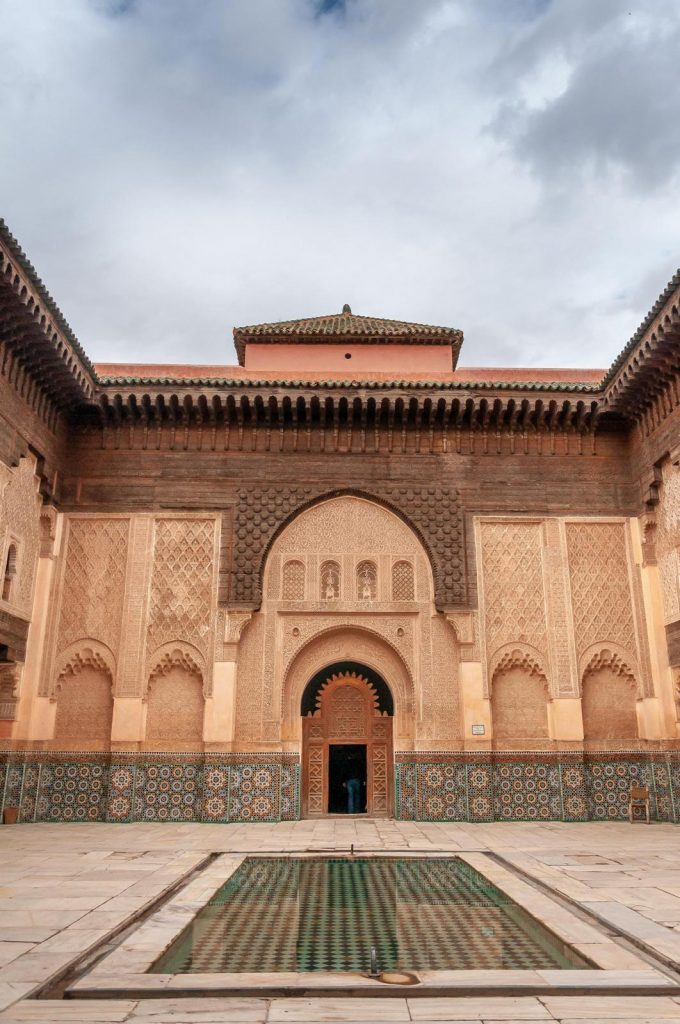
ARCHITECTURE
Moroccan architecture is a mesmerising blend of indigenous Berber traditions, Islamic influences from the Arab world and elements brought by Andalusian refugees from Spain. Over centuries, these diverse influences have converged to create a distinctive and widely admired aesthetic.
Ornate Arches such as the horseshoe arch, with its graceful curves, is ubiquitous in Moroccan architecture, used for doorways, windows, and decorative elements. Other arch types include pointed or “broken” horseshoe arches, polylobed arches, and the more ornate lambrequin arches, all adding to the visual richness.
Courtyards and Gardens are central to most traditional Moroccan homes (Riads) and palaces, courtyards provide private, open-air living spaces. They serve as a serene oasis, offering natural light, ventilation, and a sense of tranquillity away from the bustling streets. These courtyards often feature fountains, lush greenery, and orange or lemon trees, reflecting Islamic garden traditions.
Moroccan architecture is celebrated for its use of vibrant, rich, bold colours. While the exterior walls of some cities (like Chefchaouen’s blue or Marrakech’s ochre) are distinctive, the interiors burst with hues in zellige, painted wood, and textiles.
Traditional Moroccan buildings often have relatively plain and unassuming exteriors, especially in medinas. The true artistry and lavish decoration are reserved for the interiors, reflecting a desire for privacy and creating a surprising contrast for those who enter.
The Koutoubia Mosque (Marrakech) is an iconic 12th-century Almohad mosque with a striking square minaret, serving as a landmark in Marrakech. The Hassan Tower (Rabat) is an unfinished minaret of a 12th-century mosque, still a significant landmark in Rabat, reflecting grand Almohad architectural ambition.The mosque minarets (towers) vary in design, from the square, cuboid style (common in the Maghreb) to the octagonal minaret of Chefchaouen or the more modern, soaring minaret of the Hassan II Mosque.
The Hassan II Mosque (Casablanca) is a monumental achievement of modern Moroccan architecture. It is one of the largest mosques in the world, featuring the tallest minaret (210 meters) and intricate details of zellige, carved wood, and stucco. Part of it is built directly over the Atlantic Ocean.
Ben Youssef Madrasa (Marrakech) and Bou Inania Madrasa (Fes) are former Islamic colleges and masterpieces of Marinid architecture, celebrated for their exquisite courtyard designs, intricate zellige, carved plaster, and cedar woodwork.
Aït Benhaddou (near Ouarzazate) is a UNESCO World Heritage site, this fortified village (ksar) is an outstanding example of traditional pre-Saharan earthen architecture, with its impressive mud-brick kasbahs.
The Medinas of Fes, Marrakech, Tetouan, and Meknes are UNESCO-listed old cities are living museums of traditional Moroccan urban planning and architecture, with their narrow alleyways, hidden riads, bustling souks, and historic gates.
The Royal Palaces are not fully accessible to filming. However, the exteriors and monumental gates of royal palaces in cities like Fes and Rabat offer ideal glimpses into regal Moroccan architecture.
The Bahia Palace (Marrakech) is a stunning 19th-century palace renowned for its opulent courtyards, intricate zellige work, painted cedar ceilings, and sprawling gardens, showcasing the peak of Moroccan decorative arts.
Kasbahs are the fortified residences and citadels found throughout the country, particularly in the south (e.g., Telouet Kasbah, Taourirt Kasbah), often built from earth and offering a more rustic yet grand architectural style.
Moroccan architecture is a testament to the country’s rich history, diverse cultural influences, and unparalleled craftsmanship, spaces that are both functional and deeply artistic.
